Temperature Variable Scanning Tunneling Microscope
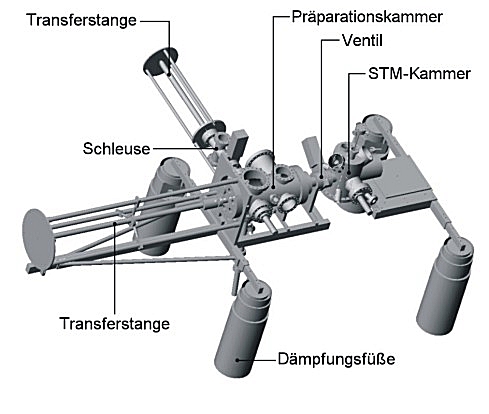 We use a variable temperature scanning tunneling microscope (VT-STM) for our experiments. The VT-STM operates in ultra-high vacuum (10-10 mbar) in a temperature range from 16 to 300 K. The vacuum setup includes standard vacuum components as pumping units and all facilities for sample preparation.
We use a variable temperature scanning tunneling microscope (VT-STM) for our experiments. The VT-STM operates in ultra-high vacuum (10-10 mbar) in a temperature range from 16 to 300 K. The vacuum setup includes standard vacuum components as pumping units and all facilities for sample preparation.
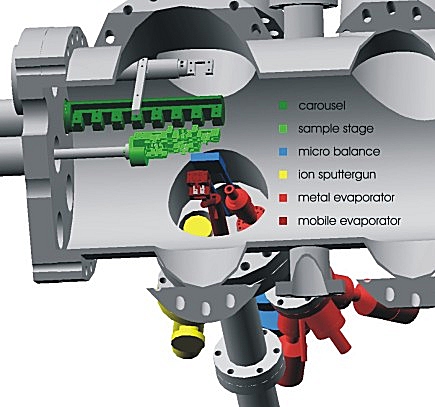 In this system we installed sample stages for sputtering, oxygen flashing, and annealing of metallic single crystals up to 2100 C. After preparation of atomically flat substrates, thin layers of organic, metallic, magnetic, and insulating adsorbates can be thermally deposited or injected as fluents or in the gas phase.
In this system we installed sample stages for sputtering, oxygen flashing, and annealing of metallic single crystals up to 2100 C. After preparation of atomically flat substrates, thin layers of organic, metallic, magnetic, and insulating adsorbates can be thermally deposited or injected as fluents or in the gas phase.
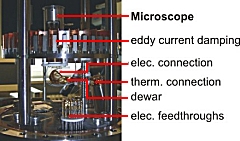 On the right, a direct view of the real experimental setup of the microscope is given. Whereas the whole setup already rests on pneumatic damping legs the microscope itself is mounted on an eddy current damped table.
On the right, a direct view of the real experimental setup of the microscope is given. Whereas the whole setup already rests on pneumatic damping legs the microscope itself is mounted on an eddy current damped table. Further Reading: A versatile variable-temperature scanning tunneling microscope for molecular growth Stefan Kuck, Jan Wienhausen, Germar Hoffmann, and Roland Wiesendanger,
Rev. Sci. Instr. 79 083903 (2008)
Low Temperature Scanning Tunneling Microscope
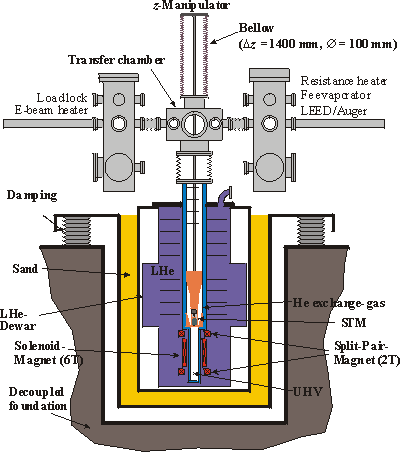 High stability scanning tunneling spectroscopy and spin-polarized scanning tunneling microscopy experiments for the investigation of electronic and magnetic molecular properties a LT-STM is available. In this LT-STM setup, all facilities for insitu preparation of magnetic molecular surfaces as well as magnetic tips are installed. The experiments are performed at 7 K with magnetic fields available to control the in-plane magnetism (upto 2 Tesla) and out-of-plane magnetism (upto 6 Tesla). Once the sample is installed, the contamination level is as low as 1 adsorbate per 1 micrometer per 1 week.
High stability scanning tunneling spectroscopy and spin-polarized scanning tunneling microscopy experiments for the investigation of electronic and magnetic molecular properties a LT-STM is available. In this LT-STM setup, all facilities for insitu preparation of magnetic molecular surfaces as well as magnetic tips are installed. The experiments are performed at 7 K with magnetic fields available to control the in-plane magnetism (upto 2 Tesla) and out-of-plane magnetism (upto 6 Tesla). Once the sample is installed, the contamination level is as low as 1 adsorbate per 1 micrometer per 1 week.
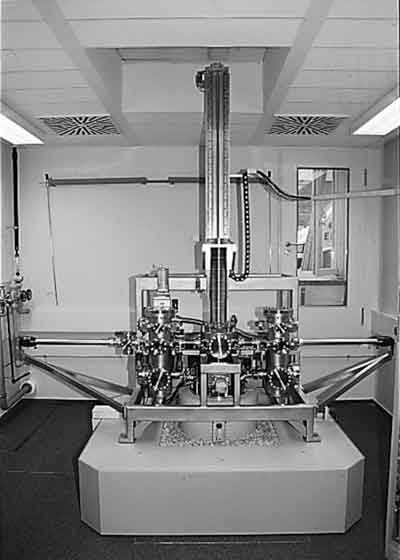
The right image shows a direct view onto the experimental setup. The whole setup rests on damping legs for mechanical isolation. The dewar system to maintain the operation temperature is located below the vacuum system and built into the ground. Respectively, samples are loaded from the top.
Further Reading: A low-temperature ultrahigh-vacuum STM/STS-system with rotatable magnetic field Ch. Wittneven, R. Dombrowski, S.H. Pan, and R. Wiesendanger
Rev. Sci. Instr. 68 3806 (1997)